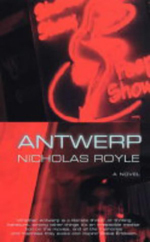Recent reading, August 2004

In any way, it hardly seems to matter what is or isnít fiction in this fantastic book. Ostensibly a thriller, itís as much an evocation of a city - any city, or a psychological study of obsession as your classic murder investigation. Though of course there are murders in here, pretty nasty ones as it turns out, along with forgotten buildings, red light districts and a cast of damaged and lost characters in search of a plot. Somehow, through a mix of jumpcuts and narrators, the plot slowly unravels, implicating almost everyone: no-one is innocent in this seedy city. The pace and dislocations get faster and faster, the chapters and paragraphs shorter and shorter as we head for the ending, which is curiously unresolved in traditional terms.
Thereís a Ďcoolí kind of coda, set in the NFT, London, and then itís all over. Itís an intriguing, at times annoying, rich and baffling book, full of knowing references and allusions to the obscure. If you like Ballard, Burroughs, Steve Erickson and Iain Sinclair, youíll like this too.
And you can also file Conrad Williamsí London Revenant on the same shelf. Williamsí London has a lower level to it, an alternate reality which slowly consumes those acclimatised to its existence. Someone is pushing people under tube trains, and elsewhere Adam Buckley is falling apart after a relationship ends. Slowly, he finds out who he is [or might be] and what else surrounds the city he thinks he knows. At times, London Revenant verges on pastiche, at times it tries to hard and loses the plot [literally; though plot may be too strong a word - this book is just as much about sense of place and location as any story]. But the taut prose and slippery, elusive images and set pieces, the loving description of shadowy corners and forgotten streets, keeps you reading until itís strange, unreal finale.
A few centuries earlier, we find the London of JP Taylorís Wormwood, a gothic supernatural tale, ostensibly for children, featuring the undead, the about-to-die, cabbalists, angels, astronomers, alchemists and the usual cast of children, beggars, publicans, gentry and innkeepers one needs to people any novel set in this place. Itís a claustrophobic and enticing tale, one that seduces and sucks you in, and keeps you reading. I found it luridly violent, at times quite nasty, and the underlying yes/no morality and spirituality of the story sits rather uneasily with its magical content. Taylor is on record as worrying about the witchcraft and magic used in the Harry Potter books and any celebration of the dark arts, but his christian riposte - this and another novel Iíve not yet read - seem to me much nastier and dangerous places than those which Rowling creates.
And finally, three reference works about London, the type of book that any of the above authors may have used to help construct their cities. Gavin Weightmanís Londonís Thames is a straightforward and hugely knowledgeable history of the river, which manages to mention lots of intriguing asides, facts and pearls of wisdom as it flows through the years from Twickenham to Woolwich. Ed Glinertís The London Compendium is even better, though to my mind strangely organised into loosely grouped geographical areas. Here, Glinert provides street-by-street references to events, buildings and personages throughout [mainly] central London. From forgotten rock and jazz clubs, to murders and fights, via alleyways and pubs, this is a fantastic, wide-ranging 500 pages.
London from Punk to Blair is a more academic tome, beautifully produced by Reaktion Books. Generously sprinkled throughout with great photographs, itís divided into four sections dealing with Ethnicity/Identity, Politics/Economics, Infrastructure, and Culture/Subculture; each consisting of a series of individual essays. Nicholas Royle offers ĎAbandoned Buildingsí, complemented [in the Infrastructure section] by Patrick Wright and others discoursing on tower blocks, the tube, architecture and animals amongst other things. But the final section on Culture is my favourite. Here Michael Bracewell discusses punk, poet and artist Allen Fisher conjures up Brixton, Roger Luckhurst details ĎOccult Londoní and Patrick Keiller discusses the city and our perception of it in the 1990s. Itís heady stuff and often difficult reading, which at times is as complex and dysnfunctional as the work of the authors and artists it discusses: Iain Sinclair [again] and many other, known and unknown, suspects. Itís a glorious oversize volume with lots to read and look at - the real proving once again every bit as fascinating and bizarre as the fictional and invented.
© 2004 Rupert Loydell